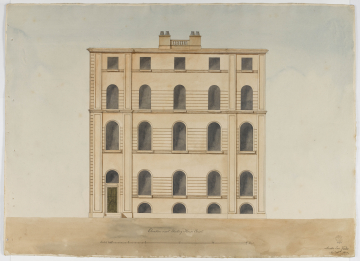
Browse
Reference number
Purpose
Aspect
Scale
Inscribed
Signed and dated
- Lincolns Inn Fields / Novr 18th 1817
Medium and dimensions
Hand
Notes
The drawing shown here is a reduced copy of SM 48/2/26 (or vice versa). The design for the side elevation relates strongly to that for the front. The proportion of height to width is close and if the ground floor is excluded, the windows and panel pilasters are the same throughout, though the centre three bays of the attic and second floors are not recessed. This design for the Meeting House Court front is the earliest (surviving) design except for glimpses in perspectives (SM 48/2/4, SM 48/2/6 and SM 48/2/26).
Level
Sir John Soane's collection includes some 30,000 architectural, design and topographical drawings which is a very important resource for scholars worldwide. His was the first architect’s collection to attempt to preserve the best in design for the architectural profession in the future, and it did so by assembling as exemplars surviving drawings by great Renaissance masters and by the leading architects in Britain in the 17th and 18th centuries and his near contemporaries such as Sir William Chambers, Robert Adam and George Dance the Younger. These drawings sit side by side with 9,000 drawings in Soane’s own hand or those of the pupils in his office, covering his early work as a student, his time in Italy and the drawings produced in the course of his architectural practice from 1780 until the 1830s.
Browse (via the vertical menu to the left) and search results for Drawings include a mixture of Concise catalogue records – drawn from an outline list of the collection – and fuller records where drawings have been catalogued in more detail (an ongoing process).

